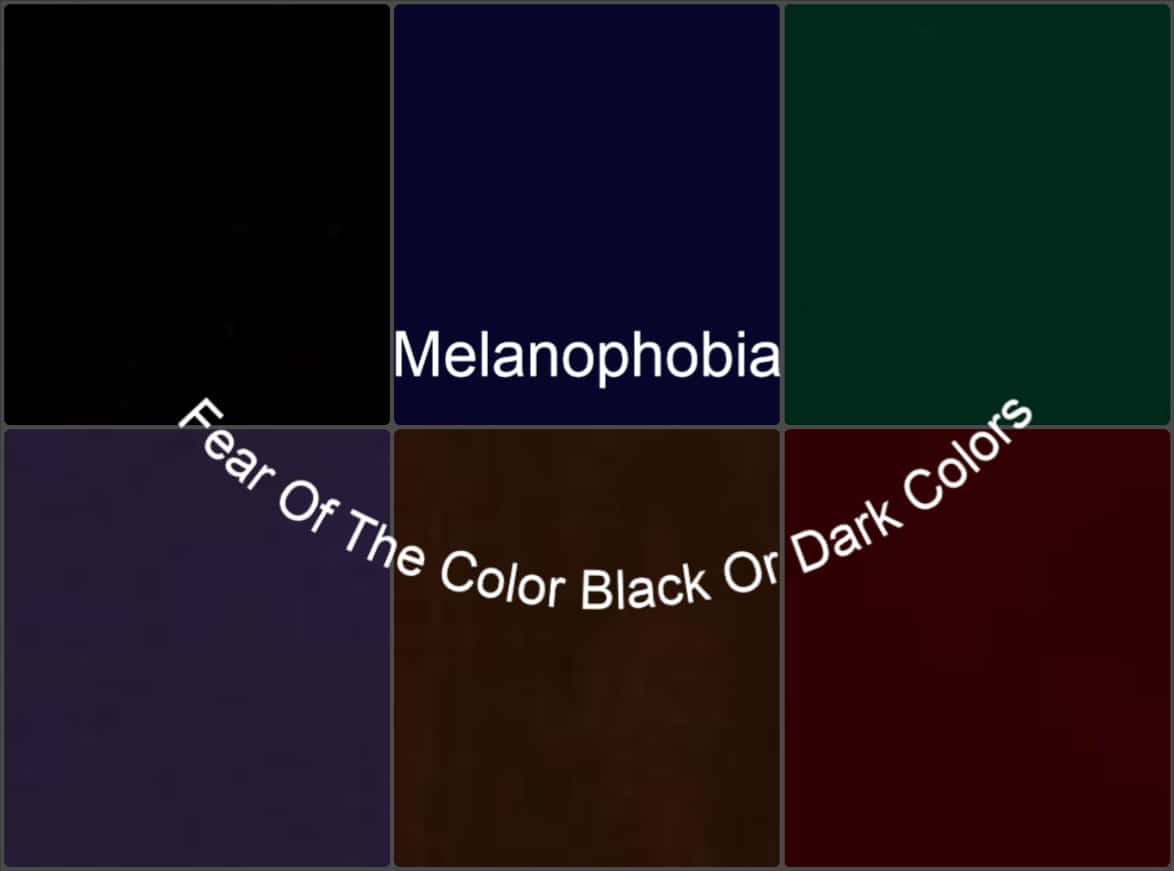Share This Article
Melanophobia: Rare but Real
Do you find yourself consciously avoiding people who are dressed in black? Have you ever been freaked out by someone wearing black eyeshadow? Does the color black remind you of death, mourning, or other depressing feelings?
If so, you are probably experiencing melanophobia, a phobia of the color black.
Melanophobia is a tricky phobia to manage. After all, how long can you avoid such a common color? This fear can significantly limit someone’s life.
Like any other phobia, however, there are ways to cope with melanophobia. Here’s everything you need to know about the fear of the color black and how to treat it.

What Does Melanophobia Mean?
If you go through a common list of phobias, you’ll find a surprising number of phobias that concern seemingly common and natural things. One of these is melanophobia.
Now, you may wonder, is melanophobia a real thing? Unfortunately, it is.
Melanophobia is the fear of the color black. A person with this melano color phobia will find themselves avoiding anything colored black. This can be difficult as it’s such a common color and often a significant part of special events.
For example, in the Western world, the color black is associated with mourning and death. This makes it difficult for someone suffering from melanophobia to attend funerals.
People who are obsessed with cleaning may also develop this fear as they will associate the color black with dirt and dust.
A person suffering from melanophobia may also develop nyctophobia, a fear of the dark. They may tend to avoid going out at night or sleeping in a dark room.
Melanophobia Causes
Like all other phobias, knowing the exact cause of melanophobia is not possible. However, there are several factors that may contribute to the development of this phobia.
Genetics
A person may be predisposed to developing phobias. If, for example, there is a family history of phobias or someone in the family has an anxiety disorder, the chances of someone developing melanophobia increase.
Environmental and Cultural Factors
The environment a person is raised in can significantly impact their mental health. If a person has been subjected to emotional trauma or has been taught to associate the color black with negative emotions, there is a greater likelihood of them developing melanophobia.
Many cultures also associate the color black with death and mourning. And if someone faces the loss of a loved one, they may associate their loss with the color black, which can then result in a phobia.
Past Experiences
Often, children see or listen to horror stories that are often portrayed in the dark or have a lot of dark colors associated with them. They may even have been traumatized by someone trying to scare them using the color black. Such experiences can lead to connecting the color with a fear response, which may develop into a phobia.
Melanophobia Symptoms
Depending upon the severity of the phobia, a person may experience multiple or all of the symptoms listed below.
Physical Symptoms
- Sweating
- Nausea
- Irregular heartbeat
- Perspiration
- Dry mouth
- Headache
- Diarrhea or abdominal pain
- Insomnia
- Trembling
- Inability to articulate words or sentences
- Muscle tension
Physiological Symptoms
- Anxiety when seeing or thinking about the color black
- Feeling disconnected
- Feeling the presence of someone
- Afraid to go out at night
- Hallucinations
Melanophobia Treatment
There is no specific treatment for melanophobia. Typically, the treatments used to treat other phobias are also applicable to this phobia. And often a combination of two or more treatments is used for treating the phobia of the color black.
Self-Help
People with melanophobia realize that their fear is irrational and they can work around that to overcome their phobia. The first step to self-help is recognizing and accepting their fear of the color black. They need to understand that the color poses no risk on its own and that their fear stems from whatever they are associating with the color.
It’s also important to share your fears and thoughts with close friends or family members whom you trust and try to build one’s confidence.
Yoga and Exercise
Yoga and exercise in general are known to show positive effects on people suffering from anxiety disorders like phobias. Exercise releases endorphins and can help you cope with stressful situations. Yoga helps one achieve a meditative state, which helps relieve anxiety and redirects your attention to more rational and healthy thoughts.
Therapies
Therapies are widely used to treat specific phobias like melanophobia. If a person is not able to overcome their fear with self-help, it is advisable that they seek professional help.
The therapist will access the severity of the phobia and create a treatment plan with the necessary therapies and medication if necessary. Some of the therapies the doctor may consider to treat melanophobia are:
Exposure Therapy
In this therapy, the patient is gradually exposed to the object of their fear in the presence of a professional and in a controlled environment. A patient with melanophobia will first be exposed to objects with small patches of black and gradually move on to holding completely black objects until they have no severe negative reaction to them.
Cognitive Behavioral Therapy (CBT)
CBT works on the principle that our thoughts and beliefs influence our behavior. Through this therapy, the patient is guided to replace their negative and irrational perceptions related to the color black with more positive and rational thoughts.
Medication
A doctor will only prescribe medication if the melanophobia is severe and if no other therapy has worked. The medication will be stopped once the patient starts responding to therapies. The medications help relieve the symptoms of the phobia such as panic attacks and anxiety. Generally, anti-anxiety drugs and anti-depressants are prescribed for patients with melanophobia.
Learning to Cope with Melanophobia
In a world full of colors, living with melanophobia can become restrictive. It may drastically affect a person’s life and disrupt their daily activities. It is important for those struggling with melanophobia to acknowledge their fear and seek necessary treatments.
Self-help has shown very positive results in dealing with anxiety. Coupled with other therapies, melanophobia can be treated.
In Conclusion
Melanophobia, the fear of the color black, can affect the normal functioning of an individual. And although it may not seem serious, it can have a lasting, negative impact on the person. With regular treatment, however, the phobia can be easily managed.




